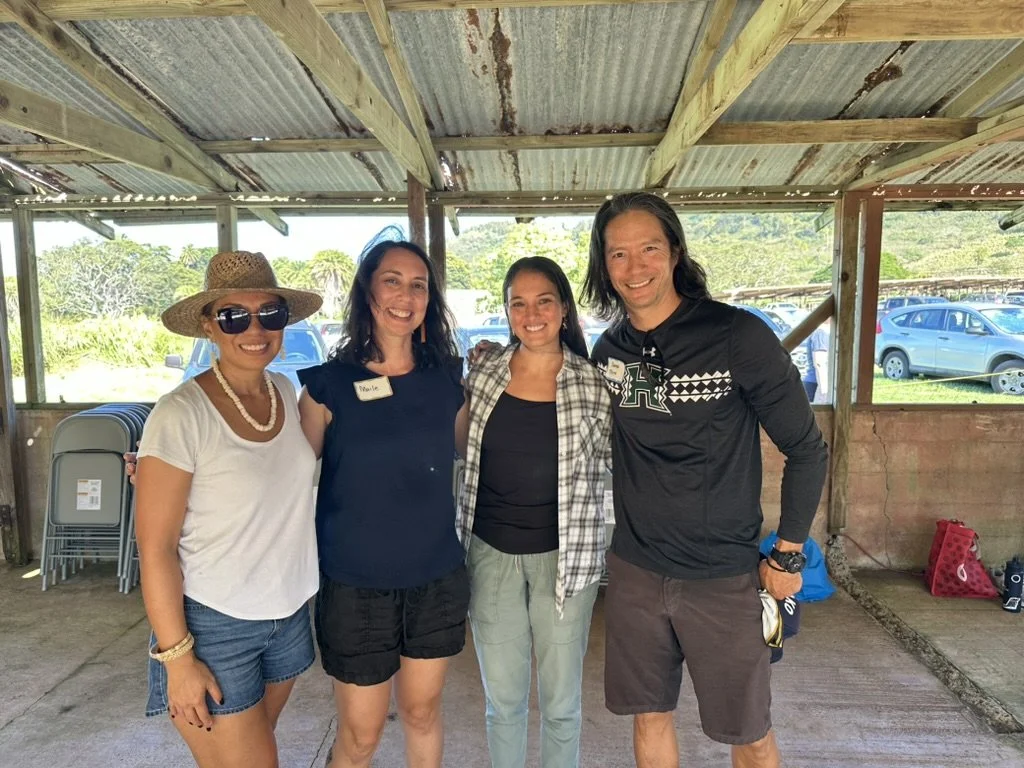Updates, with a full heart after connections at Waialeʻe
What a whirlwind time it has been for everyone. This blog post shares a few updates on recent events and a new publication.
Mahalo e Waialeʻe
Three weeks ago, on Saturday Oct 19th, many of us gathered at Waialeʻe. We had a wonderful day sharing space and manaʻo with folks from the North Shore Community Land Trust, UH Sea Grant, KUA, Townscape, and most importantly, many community members who have long-standing pilina (relationships, ties) to Waialeʻe, or who were descendants of boys formerly incarcerated at the Industrial School for Boys. Townscape is working on a report summarizing the community input gathered that day, which we will share publicly soon. Mahalo to everyone who made the day possible and meaningful.
You can find photos and videos of the day on our Facebook and Instagram pages. The ʻāina of Waialeʻe is so beautiful, as is the work NSCLT is doing to restore the loʻi kalo (taro fields) and Kalou, the loko iʻa (fishpond) to lako pono (a state of abundance). You can join the work on the last Saturday of every month. The next one is Saturday, November 23rd. Find more details and sign-up here. Also be sure to check out a recent blog post by Eliana on a remarkable story of one boy who swam six miles out to sea to get away from the industrial school.
The Biden apology & NABS events in Hawaiʻi
A week after our time at Waialeʻe, President Biden apologized for the federal government’s role in federal Indian boarding schools. Though it may have come as a surprise to some, we have to understand the apology within at least two larger contexts. First, there has been a long history of advocacy for federal actions like this, by groups including the National Native American Boarding School Healing Coalition (NABS). Those efforts have born some fruit under the leadership of Department of Interior Secretary Deb Haaland, who spearheaded the release of two reports (one in 2022 and one in 2024) on federal involvement in “federal Indian boarding schools.” Several institutions in Hawaiʻi were included in this report, including the Waialeʻe Industrial School for Boys. Second, the apology was undeniably an effort to rally support to elect Kamala Harris. Even if she had been elected, we cannot know what the follow-through may or may not have been; but the uncertainty is even greater under a second Trump presidency.
I have written before about the similarities and differences between the industrial schools I study in Hawaiʻi and Native American boarding schools, and what the report gets wrong about Hawaiʻi. I will simply say here that the way that Native Hawaiians have been included in the federal reports on boarding schools and larger initiative leaves a lot to be desired. Many of you may have heard that there is a series of events hosted by the National Native American Boarding School Healing Coalition in Hilo and Kāneʻohe later this month. To be clear, I am not personally involved in those events; nor is our project Nā Lei Poina ʻOle involved. I support the overall cause of healing from institutional violence and intergenerational trauma - indeed, this is at the heart of this project - and greatly respect many who are participating in these events. I also think the November events are part of a top-down process that is not fully prepared to engage Native Hawaiian history with the care and time our communities deserve. How things proceed matter. This is lifetimes long, generations of healing work. I am interested in it for the long term, not just this election cycle.
New open-access article published
After many years in the works, my first academic article on the history of industrial schools in Hawaiʻi has been published, in open-access format here. Here is a sneak preview, and the full citation below.
In 1929, Dorothy Wu, a multiracial Native Hawaiian and Chinese teenager, suddenly found herself a ward of the Salvation Army Girls’ Home in Honolulu, Hawaiʻi, then a US territory. Until her institutionalization, Dorothy had worked as a maid in the home of Princess Abigail Campbell Kawānanakoa, a member of the aliʻi or ruling, royal class of the formerly independent Hawaiian Kingdom. To Dorothy’s bewilderment, the Princess abruptly fired Dorothy for “associating with boys,” and recommended her commitment to the Girls’ Home, where she could be “better cared for.” Dorothy found the Salvation Army matrons mean. She complained that they discriminated against “darker girls” like her. After six months, Dorothy ran away. Her escape soon landed her in juvenile court, which sentenced her to the Kawailoa Training School for Girls, a recently opened juvenile detention facility, where matrons worked to shape “wayward girls,” the majority of whom were Native Hawaiian and/or Asian, into “proper” and modern American women.
Arvin, Maile. “Replacing Native Hawaiian Kinship with Social Scientific Care: Settler Colonial Transinstitutionalization of Children in the Territory of Hawaiʻi.” Chapter. In Empire, Colonialism, and the Human Sciences: Troubling Encounters in the Americas and Pacific, edited by Adam Warren, Julia E. Rodriguez, and Stephen T. Casper, 123–52. Cambridge: Cambridge University Press, 2024.

